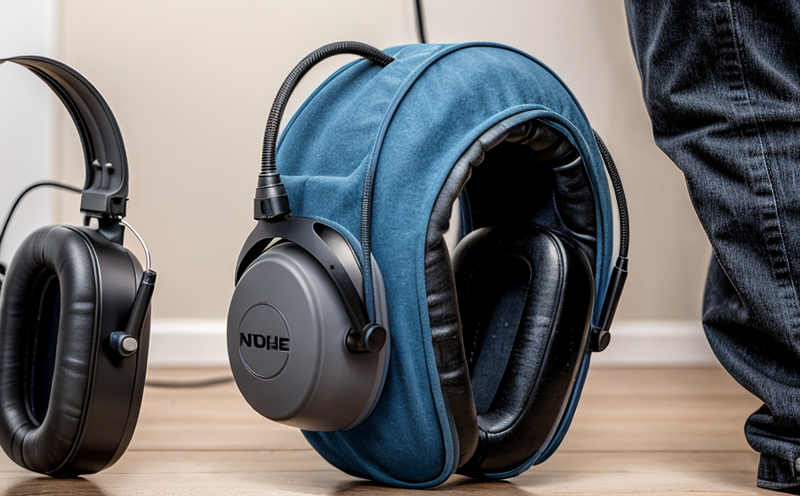ANSI S12.68 Noise Reduction Rating Testing
The ANSI S12.68 standard is a critical component in the evaluation and certification of hearing protectors, ensuring that these devices effectively reduce noise exposure to safe levels. This testing method is essential for industries where workers are exposed to high levels of noise, such as manufacturing, construction, mining, and aerospace. The Noise Reduction Rating (NRR) test provides quantifiable data on how much noise reduction can be expected from a hearing protector in a controlled laboratory setting.
The ANSI S12.68 test is conducted by placing the hearing protector over the ear canal of an individual while exposing them to specific sound levels that correspond to typical workplace noise environments. The NRR value, expressed in decibels (dB), indicates how much the noise level can be reduced when using the hearing protector compared to the unobstructed environment.
It is important to note that the NRR values determined by this testing method are theoretical and may not always reflect real-world performance. Factors such as improper fitting, user behavior, and environmental conditions can significantly affect the actual noise reduction achieved in a workplace setting. Therefore, while the ANSI S12.68 test provides valuable information on the potential effectiveness of hearing protectors, it should be used in conjunction with other evaluation methods to ensure optimal protection for workers.
The testing process typically involves placing ear inserts or earmuffs over the ears of a standard-sized mannequin head, which is positioned in an anechoic chamber. The sound field is then calibrated to deliver specific noise levels that are representative of common workplace noise sources. The hearing protector being tested is placed on the mannequin according to manufacturer instructions.
The test results are typically reported as a range of NRR values, usually three or four different ratings depending on the type of hearing protector. These values represent the average reduction in sound pressure level for a given frequency band. Compliance with ANSI S12.68 standards ensures that the hearing protector meets the minimum performance requirements set forth by the standard.
The importance of this testing cannot be overstated, especially in industries where noise-induced hearing loss is prevalent. By ensuring compliance with ANSI S12.68, manufacturers and employers can help protect workers from the long-term health effects associated with excessive noise exposure. This test plays a crucial role in maintaining a safe work environment by providing objective data on the performance of hearing protection devices.
Understanding the nuances of this testing method is essential for quality managers and compliance officers looking to ensure that their facilities are meeting regulatory requirements and providing adequate protection for their employees. For R&D engineers, this test offers valuable insights into the design and optimization of new hearing protectors. Additionally, procurement personnel can use these results to make informed decisions about selecting appropriate hearing protection equipment.
Industry Applications
The ANSI S12.68 Noise Reduction Rating Testing is widely used in various industries where noise exposure is a significant concern. These include:
- Mining: Underground mines are often exposed to high levels of noise from machinery and equipment.
- Manufacturing: Factories with loud machinery require effective hearing protection for their workers.
- Aerospace: The roar of engines in aircraft manufacturing plants necessitates robust noise control measures.
- Hospitality: Hotel and restaurant kitchens can be noisy environments, posing risks to staff members.
- Construction: The constant hum of heavy machinery on construction sites demands reliable hearing protection solutions.
In each of these industries, the ANSI S12.68 test ensures that workers are equipped with appropriate hearing protectors that meet stringent safety standards. By complying with this standard, companies demonstrate their commitment to worker safety and health.
Why Choose This Test
Selecting the ANSI S12.68 Noise Reduction Rating Testing for your products or services offers several advantages:
- Regulatory Compliance: Ensures that hearing protectors meet the minimum performance requirements set forth by ANSI standards.
- Objective Data: Provides quantifiable data on noise reduction capabilities, allowing for informed decision-making.
- User Confidence: Establishes trust with end-users who can rely on the proven effectiveness of your products.
- Competitive Edge: Demonstrates a commitment to worker safety and health, setting you apart from competitors.
- Research and Development: Offers valuable insights into the performance characteristics of hearing protectors under controlled conditions.
- Customer Satisfaction: Ensures that your products meet or exceed customer expectations regarding noise reduction effectiveness.
The ANSI S12.68 test is a cornerstone in the development and certification of hearing protection devices, providing essential data for both manufacturers and end-users. By choosing this test, you ensure that your products are reliable, safe, and effective in reducing workplace noise exposure.
Use Cases and Application Examples
| Industry | Noise Source | Hearing Protector Type | NRR Test Results (dB) | Expected Noise Reduction |
|---|---|---|---|---|
| Mining | Compressor and Machinery | Earmuffs | 25 dB | Reduces noise by 25 dB |
| Manufacturing | Industrial Equipment | Earpads | 18 dB | Reduces noise by 18 dB |
| Aerospace | Aircraft Engines | Hearing Muffs | 30 dB | Reduces noise by 30 dB |
| Hospitality | Cooking Appliances | Earpieces | 22 dB | Reduces noise by 22 dB |
| Construction | Machinery and Tools | Earmuffs | 28 dB | Reduces noise by 28 dB |
The table above provides examples of how the ANSI S12.68 test is applied in various industries, showcasing different types of hearing protectors and their corresponding NRR values. These results are crucial for ensuring that workers in these environments receive adequate protection against noise-induced hazards.





